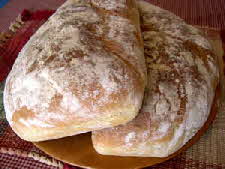SECRETS OF GREAT BREADSOften we field questions about making great bread. Great bread is a matter of using the right ingredients and the right techniques—there’s no single secret that will make perfect bread. But really great bread is readily attainable. We’ve compiled our list of what goes into great bread.
1. The right flour.
2. An understanding of yeast.
3. A good dough conditioner.
4. A baker’s thermometer
Now this isn’t everything that goes into great bread but the baker that is armed with these four tools are likely to be baking great bread. Recently we stated that if there is a secret ingredient that bakers use it’s the flour. So we put the right flour on the top of our list.
To understand how important flour is, you need to understand just a little about gluten. Gluten strands are formed from the proteins naturally occurring in wheat flour. It's what gives bread its chewy texture. If you use a flour with a higher percentage of protein, you will have more gluten. Most commercial bread bakers are going to use flours with 10 to 14% protein--bread flour.
Commercial bakers have access to dozens of different flours. If you want really good bread, buy a good quality bread flour--even if you have to make a deal with a local baker.
If you buy your flour at the grocery store be aware that all flours are not equal. For bread you want a bread flour. Name brands are likely to do a better job of holding to a specification and will provide more consistent results. You can get an idea of the protein content from the nutrition label. Divide the grams of protein by the grams in the serving size to get the approximate percentage of protein in the flour (subject to rounding error). For home baking, you want at least ten percent and preferably higher. 
Yeast is a living organism. The gases expelled by the growing yeast are what leavens the bread. The skilled baker recognizes that with the dough, he or she is culturing a living organism and that the yeast must be growing in the right culture to create the gases to make light airy bread. The right culture is primarily a function of moisture, temperature, and pH or the acidity level. Read on to learn more about yeast and how it functions >>>
This brings us to our dough conditioner. Dough conditioner alters the pH of the dough (among other things) so that it enhances the growth of the yeast and it makes the dough more extensible. All else being equal, dough conditioner can make a good bread great. You can buy dough conditioner (or dough enhancer as it is sometimes called) in some grocery stores or you can order it online at www.preparedpantry.com
And finally, a thermometer has been called the baker’s secret weapon. We would not think of making bread without one. We use it to measure water temperature. (When we use our bread machines, we measure the water temperature to exactly 80 degrees—not one degree off. When we make bread in our stand-type mixer or by hand, we use water between 100 degrees and 110 degrees.) We nearly always measure the temperature of the bread when it comes from the oven. And you can use a thermometer to measure the temperature of the dough to make sure that you have the right temperature for your yeast to thrive in. An insta-read thermometer is best.
Courtesy of the Prepared Pantry - www.preparedpantry.com
| 